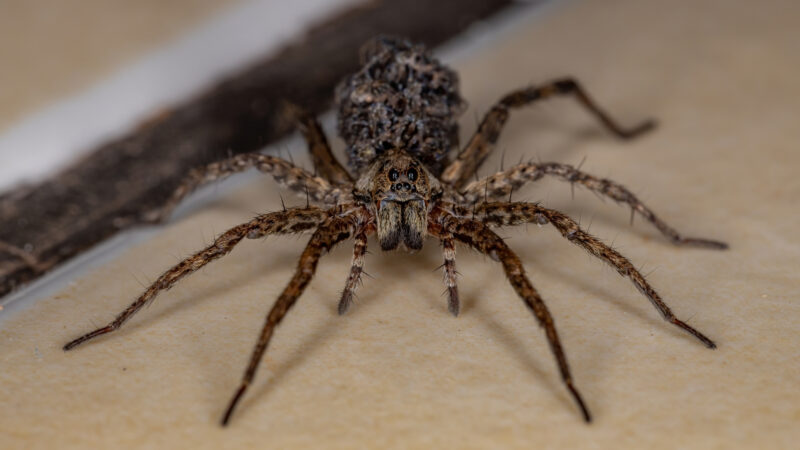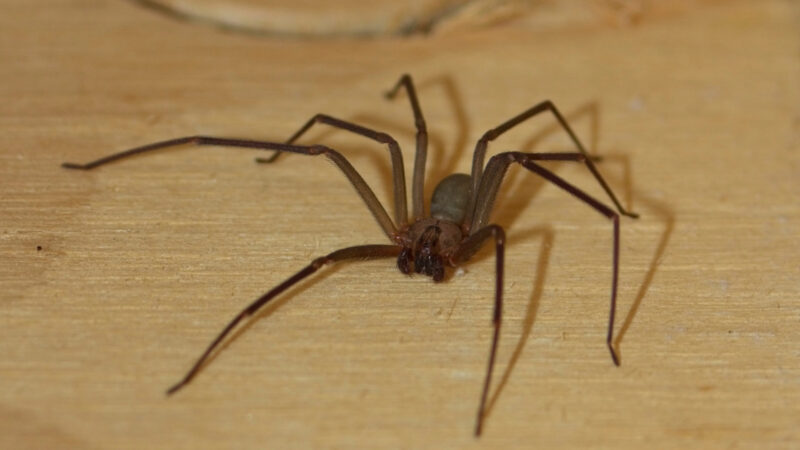If you’ve seen brown spiders in and around your property, you may start feeling anxious and want to identify if they are wolf spiders or brown recluse spiders.
These two are often mistaken for each other due to the similarity of their size and color.
What’s the difference between wolf spiders and brown recluse spiders? The difference between wolf spiders and brown recluse spiders is that wolf spiders have hairy bodies, while brown recluse spiders possess smooth bodies. On top of that, the wolf spiders have multi-colored markings on their backs, while the brown recluse only has one color—brown.
By further reading this guide, you will know more about the differences between the wolf spiders and the brown recluse spider.
We will also reveal the respective characteristics of these spiders so that you can identify the two easily.
Table of Contents
How to Identify a Wolf Spider?

You can identify wolf spiders by their hairy appearance and brown, tan or gray color. They also have several dark lines or markings with black undersides and are around half an inch to two inches long.
What Do Wolf Spiders Look Like?
Wolf spiders are among the most common species of spiders. They are quite big at around two inches long with usually dark brown color and pale markings. There are also gray and tan colors of these spiders.
Is There a Spider That Looks Like a Wolf Spider?
There are times when you may misperceive other spider species as wolf spiders. Several spider species have a similar look to the wolf spiders, such as:
- Brown recluses
- Jumping spiders
- Huntsman spiders
- Hobo spiders
- Prowling spiders
- Grass spiders
- Two-tailed spiders
- Swift spiders
What Time of Year Are Wolf Spiders Most Active?
Wolf spiders are often found in homes during fall to prepare for winter. Houses are ideal places for them to stay warm and have enough food for the season since other insects may also overwinter in your house.
Brown Recluse | Identification

While most spiders have eight eyes in two rows of four, the brown recluse only has six pairs of eyes with only a space dividing the pairs. On top of that, brown recluse spiders have a deep brown color violin-shaped on the cephalothorax, pointing back toward the abdomen.
Also, note that the brown recluse’s legs are not streaked or spiny like most spiders it is often mistaken with. While females construct flat, sheet-like webs to help them catch prey, the males always roam around to search for prey.
You can also identify these spiders with the following characteristics:
1. Uniformed colored legs and abdomen.
Brown recluse spiders have uniformed colored legs and abdomen. So, if you spot spiders with multi-colored legs and abdomen, those are not recluses.
2. Just six eyes, never eight.
While most spiders have eight eyes, brown recluses only have six. These eyes can easily be seen using a minor magnification.
However, you must be aware of other spiders with the same eye pattern as the brown recluses, such as the Scytodes. These spitting spiders are common all around the world.
However, if you look at them closely, you will notice that they have more than one color on their abdomen and legs—signs that they are not recluses.
3. The dark violin pattern.
Another confirmation that it’s a brown recluse spider is if you’ve spotted the dark violin mark on a spider’s cephalothorax. However, you still have to check other factors, such as the count of the eye pattern and the color of the legs and abdomen to ensure that what you have is a brown recluse and not its look-alike.
What Does a Brown Recluse Spider Look Like?
You can identify a brown recluse spider with its dark, violin-shaped mark on the back portion of its body. These spiders also have six-eyes paired arrangements with colors ranging from tan to gray.
Is There a Spider That Looks Like a Brown Recluse?
Several spider species are often mistaken for the brown recluse, such as:
- Brown recluses
- Hobo spiders
- Huntsman spider
- Jumping spiders
- Grass spiders
- Prowling spiders
- Swift spiders
- Two-tailed spiders
The only characteristics that separate them from the recluses are their multi-colored abdomen and legs and their eight eyes. Brown recluses only have uniformed colored legs and abdomen, and their eyes are only six, not eight.
What Time of Year Is Brown Recluse Most Active?
Brown recluses tend to be more active between March and October. These spiders are mostly seen in Midwestern states and on the insides of structures.
Brown recluses also tend to flourish in the same surroundings that humans do. These spiders are most active at night and rest in concealed locations inside the structures they invade during the day.
On top of that, these spiders love constructing their retreats and resting places on wooden surfaces, such as wall voids, crawlspaces, wood furniture, basements, cardboard boxes, and attics.
Related: Are There Brown Recluse Spiders in Southern California? | Information and Control Guide
What Are the Differences Between Wolf Spiders and Brown Recluse Spiders?
The first thing you will notice about wolf spiders and brown recluses is their appearance. The wolf spiders have a hairy or furry look, while brown recluses have smooth bodies.
Furthermore, wolf spiders possess multi-colored patterns on their backs, while brown recluses only have one color—brown.
What Are the Distinct Similarities Between Wolf Spiders and Brown Recluse Spiders?

Some distinct similarities between wolf spiders and brown recluse spiders are:
- The two both have eight legs which are connected to their cephalothorax—which is basically the head and thorax.
- Wolf spiders and brown recluses also thrive in the same habitat and conceal themselves in dark, closed spaces to rest and wait for their prey to show up.
In addition, both don’t like human contact since they are quite shy.
How Would You Keep Wolf Spiders and Brown Recluse Spiders Out of Your House?
To effectively get rid of wolf spiders and brown recluse spiders out of your house, here are four efficient tips to help you do that:
1. Inspect the insides of your home for spider signs.
Before you can get rid of spiders, first you have to know their hiding places. So, make an effort to search for the traces of wolf spiders and brown recluse spiders.
Since the two thrive in the same environment, you don’t have to look for them separately. These two spiders both love to hide in dark places, so you can start your search around the basement, attic, cardboard boxes, wall voids, etc.
2. Sealing cracks in your home.
Another way to keep brown recluse and wolf spiders out of your house is to seal up gaps and cracks where these spiders can enter. This means going thoroughly to every inch of your home and looking for possible access points.
You can also add weather stripping to your windows and doors to prevent these spiders from getting in easily to your house.
3. Eliminating favorable living conditions.
Another surefire way to get rid of brown recluses is by eliminating their favorable living conditions. This means cleaning up the clutters in hidden places, such as attics and basements.
Make sure also that your storage boxes are not placed against the wall or sitting up against the wall. On top of that, ensure that your entire home is clutter-free since spiders thrive in a cluttered environment.
This method is very favorable to you since this will not only get rid of spiders but will also keep rodents and other bugs from hiding out.
4. Clean up your outside environment.
Another option you have to eliminate brown recluses and wolf spiders is by cleaning up your outside environment. If you don’t know, overgrown bushes, plants, and shrubs can aid spiders in getting inside your home, especially if they are closely settled.
So, take time to cut these greeneries to ensure no spiders, insects, or bugs can ever enter your home using these means. Also, if you see stones, piles of wood, lumber, etc., near your home, make sure to remove these items as far as possible from your house to limit their habitat.
Summary
So, these are the differences between the brown recluse and wolf spiders. When in doubt, you can always refer back to this guide to determine which is a wolf spider and a brown recluse.
You can also apply the methods given above to keep these spiders out of your property.